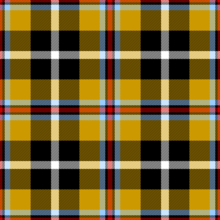- Cornish kilts and tartans
-
Cornish kilts and tartans are thought to be a modern tradition started in the early to mid 20th century. The first modern kilt was plain black, and other patterns followed. It is documented that a garment known as a bracca (a reddish checkered tunic) was worn by Celtic races that inhabited the British Isles, the term indicating its appearance.[1] The Welsh word brech means 'checkered' (compare the cognate Scottish Gaelic breac, 'variegated, freckled'), and the word bracca is derived from the Welsh or Cornish word brythen which in English translates as 'striped' or 'checkered'."[2]
Cornish historian L.C.R. Duncombe-Jewell was the first to prove that plain kilts were in use in Cornwall. He discovered that carvings of minstels dressed in kilts and playing bagpipes on bench ends at Altarnun church dated from circa 1510.[3][4] some[who?] however contend that these images are more likely to be medieval belted tunics that were common throughout Europe. The earliest historical reference to the Cornish kilt is from 1903 when the Cornish delegate to the Celtic Congress, convening at Caernarvon, L. Duncombe-Jewell, appeared in a in a woad blue kilt. John T. Koch in his work Celtic Culture: a Historical Encyclopedia mentions a black kilt worn by the Duke of Cornwall's Light Infantry in combat - however no historical reference is provided to support this claim.
Contents
National tartans
 Cornish tartan shop in St Austell
Cornish tartan shop in St Austell
First created in 1963, the Cornish National tartan was designed by the poet E.E. Morton Nance, nephew of Robert Morton Nance. Each colour of tartan has a special significance or meaning. The White Cross on a black background is from the banner of Saint Piran, the Patron Saint of tinners, which is also used as the flag of Cornwall;[5] Black and gold were the colours of the ancient Cornish kings; red for legs and beak of the national bird, the chough, and blue for the blue of the sea surrounding Cornwall.[6] A prototype of the Cornish national tartan was first worn by Morton-Nance in the 1963 Celtic Congress held at Carbis Bay attached to a Clan Douglas kilt that he was wearing for the occasion. The Cornish Hunting Tartan was registered in the 1980s.[7]
The following Cornish tartans have been registered or have been previously registered. Some of theses are Cornish family tartans which are worn at family get togethers and weddings.[8].
- Cornish National Tartan (registry #1567)
- Cornish Hunting Tartan (registry #1568)
- Saint Piran Cornish Flag Tartan (registry #1618)
- Saint Piran Cornish Dress Tartan (registry #1685)
- Cornish National Day Tartan (registry #1262)
- Christopher family Tartan (registry #2809)
- Rosevear Tartan (registry #2541)
- Curnow of Kernow Tartan (registry #4084)[9].
- Pengelly, The Cornish (STWR ref: 3145)[10]
Literature
Bedheugh benytha kernewek!
- (March of the Cornish tartan)*
Hail! Kernow's heritage, tartan. Hail! Garb of old Gaul, the kilt. Our forebears gloried in tartan - Baptized in blood Roman spilt.
E.E. Morton-Nance = Herald Bard Gwas Gweth.
References
- ^ Logan James (reprint 1976). The Scottish Gael Or Celtic Manners. John Donald Publishers Ltd. pp. 249–250. ISBN 100859760219.
- ^ http://www.caffrey.no/pages/l4_history_of_the_kilt.htm
- ^ Tanner Marcus (2006). The Last of the Celts. Yale University Press. p. 241. ISBN 0300115350.
- ^ Altarnun church
- ^ The National Archives of Scotland (16 April 2010). "The Scottish register of Tartans - Tartan Details - Kernbrownek (Personal)". The National Archives of Scotland. http://www.tartanregister.gov.uk/tartanDetails.aspx?ref=5662. Retrieved 10 April 2010.
- ^ Cornish Tartan from the Cornwall County Council website
- ^ http://www.houseoftartan.com
- ^ House of Tartan: Cornish
- ^ All tartans checked in The Scottish Tartan Authority online database "The tartan ferret"
- ^ http://www.tartanregister.gov.uk/tartanDetails.aspx?ref=5942
External links
- Cornish National Tartan
- http://www.alanrichards.org/cornishtartan.htm
- Cornish tartans
- Cornish Kilts
- Cornish Tartan Information and Images
Culture of Cornwall Symbols Celtic cross · Cornish chough · Cornish heath · Cornish kilts and tartans · Jonathan Trelawny · Michael An Gof · Saint Piran · Saint Piran's Flag

Festivals Sports Cuisine Arts Music Cornish bagpipes · Brenda Wootton · Gwenno Saunders · Fisherman's Friends
Folk songsLanguage Folklore Beast of Bodmin · Blunderbore · Bucca · Cruel Coppinger · Knocker · King Arthur · Lyonesse · Owlman · Piskie
Organisations Cornwall portal Categories:- Tartans
- Cornish culture
- History of Cornwall
- Cornish nationalism
Wikimedia Foundation. 2010.

